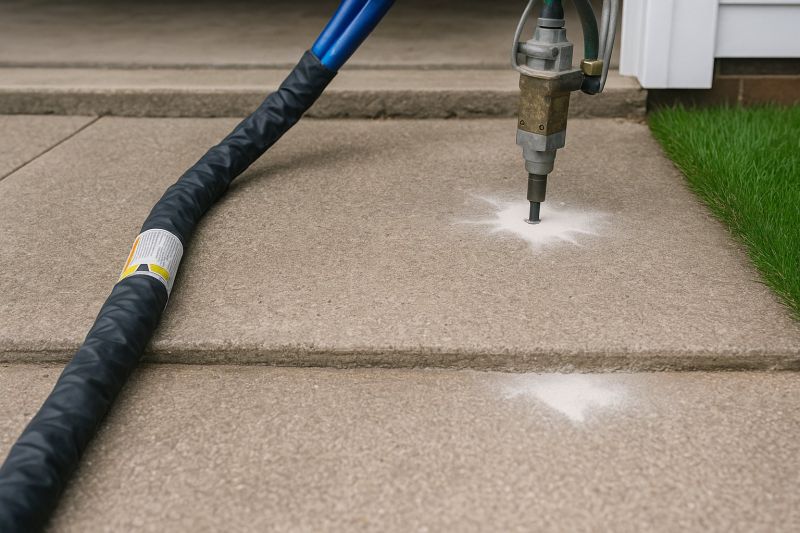Top-Rated Products For Concrete Slabjacking And Liftings You Need
Get insights into the essential products that make concrete lifting projects smoother, faster, and more durable.
 Concrete slabjacking and lifting are essential processes used to restore the stability and levelness of uneven or sunken concrete surfaces. These methods are commonly employed in residential, commercial, and industrial settings to address issues such as uneven driveways, patios, sidewalks, and flooring. The process involves injecting specialized materials beneath the affected slab to raise and stabilize it, thereby preventing further settling or cracking. Selecting the right products for slabjacking and lifting is crucial for achieving effective and long-lasting results.
Concrete slabjacking and lifting are essential processes used to restore the stability and levelness of uneven or sunken concrete surfaces. These methods are commonly employed in residential, commercial, and industrial settings to address issues such as uneven driveways, patios, sidewalks, and flooring. The process involves injecting specialized materials beneath the affected slab to raise and stabilize it, thereby preventing further settling or cracking. Selecting the right products for slabjacking and lifting is crucial for achieving effective and long-lasting results.
Top Overall Option
Polyurethane Foam Injection System
A versatile and widely used method for concrete slabjacking, polyurethane foam injection systems offer quick curing times and minimal surface disturbance. These systems are suitable for a variety of applications, providing reliable lift and stabilization for sunken slabs. They are often favored for their ease of use and ability to penetrate small cracks and voids effectively.
Types of Products For Concrete Slabjacking And Liftings
Polyurethane Foam
Lightweight, quick-curing foam that expands to lift and stabilize slabs, ideal for residential and commercial use.
Cementitious Slurry
A cement-based mixture used for filling voids and raising slabs, suitable for larger or heavier applications.
Chemical Grouts
Specialized chemical formulations designed to penetrate soil and fill voids, providing stabilization beneath slabs.
Polyurea Resins
Rapid-setting resins used for quick repairs and lifting, offering high durability and adhesion.
Epoxy Injection Materials
Used for crack repair and stabilization, often combined with lifting agents for enhanced performance.
Hydraulic Jack Systems
Mechanical jacking tools that provide manual or hydraulic lift for slabs, often used in conjunction with injection products.
Polymer-Modified Grouts
Enhanced grout formulations that improve bonding and load capacity for slab stabilization.
Self-Leveling Compounds
Materials used to create a smooth, level surface after lifting, often applied as a finishing layer.
Injection Ports and Accessories
Specialized fittings and tools designed to facilitate the injection process for various products.
Foam Delivery Equipment
Portable or stationary equipment used to inject foam or other materials into the slab for lifting.
Void Fillers
Materials specifically designed to fill large voids beneath slabs, providing support and stabilization.
Rapid-Set Repair Mortars
Fast-curing mortars used for patching and reinforcing slabs after lifting procedures.
Underpinning Materials
Products used to strengthen and stabilize the foundation beneath slabs, often involving injection or grouting.
Popular Choices
Widely used for concrete lifting projects, these kits include everything needed for small to medium repairs.
Commonly selected for larger slabs, offering a durable and cost-effective solution for raising and stabilizing.
Popular for soil stabilization and void filling beneath slabs, with various formulations available.
Preferred for manual lifting, providing precise control during slab adjustments.
Known for rapid setting and strong adhesion, suitable for urgent lifting and stabilization tasks.
Essential accessories for efficient and controlled injection of various materials into slabs.
Portable systems that facilitate the injection of expanding foam for slab lifting projects.
Popular for filling large voids to provide foundational support beneath slabs.
Used for quick repairs after lifting, ensuring minimal downtime and surface disturbance.
Chosen for projects requiring additional support beneath slabs, often involving grouting or injection.
A variety of products are available to facilitate these procedures, including polyurethane foam, cementitious slurry, chemical grouts, and other injection materials. Each type offers unique properties suited for different scenarios, such as quick setting times, high load-bearing capacity, or ease of application. Properly chosen products can help ensure a smoother lifting process, minimize surface disturbance, and provide durable stabilization.
When considering products for concrete slabjacking and lifting, factors such as the size and weight of the slab, existing soil conditions, and the desired longevity of the repair should be taken into account. Using the appropriate equipment and materials can make the difference between a temporary fix and a permanent solution. It is also important to follow manufacturer instructions carefully to ensure safety and effectiveness. Whether undertaking a small residential repair or a large commercial project, understanding the available product options can help in making informed decisions for successful concrete stabilization.
Key Buying Considerations
- Type of injection material suitable for your specific application and soil conditions.
- Load-bearing capacity and weight of the slab to determine the strength requirements.
- Curing time and setting speed of the product to match project timelines.
- Ease of application and compatibility with existing equipment or tools.
- Surface disturbance minimalism to preserve aesthetic and functional integrity.
- Durability and long-term stability offered by the product used.
- Cost-effectiveness relative to project size and scope.
- Manufacturer instructions and safety precautions for handling and application.
- Environmental conditions during application, such as temperature and humidity.
- The need for additional accessories like injection ports, hoses, or jacks.
- Compatibility with other repair materials or methods being used.
- Availability of technical support or guidance from suppliers.
- Potential for expansion or contraction within the product to accommodate movement.
- Application versatility for different slab sizes and shapes.
- Post-application surface finishing options, if needed.
